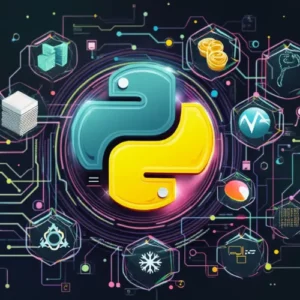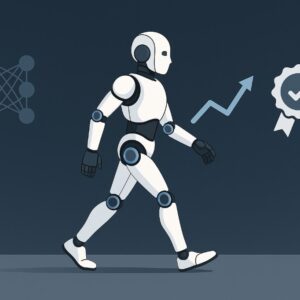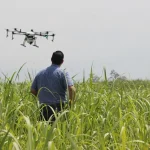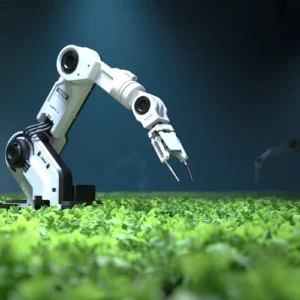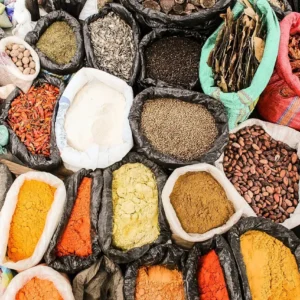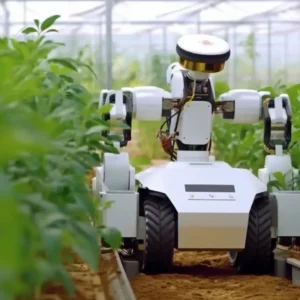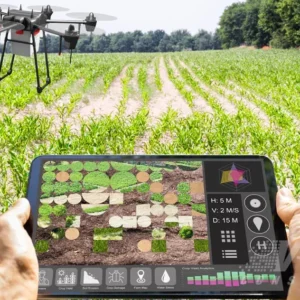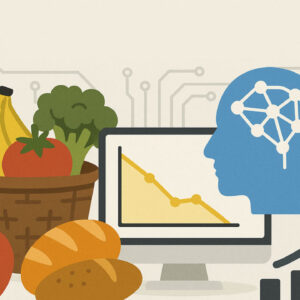The food industry has been a cornerstone of human civilization, evolving from basic manual farming techniques to sophisticated manufacturing processes. Recently, automation in the food industry has become a transformative force, bringing unprecedented levels of efficiency, safety, and innovation. Automation technologies like robotics, artificial intelligence (AI), and Internet of Things (IoT) devices are revolutionizing every stage of the food supply chain, from production and processing to packaging and distribution.
In the production phase, automated machinery and AI-driven systems enable precise planting, watering, and harvesting of crops, optimizing yield and reducing waste. IoT sensors provide real-time data on soil conditions and weather patterns, allowing for data-driven decisions that enhance crop health and productivity.
In food processing, the combination of robotics and AI streamline operations by handling repetitive tasks with high precision and speed. Robots can sort, peel, and package fruits and vegetables more efficiently than human workers, ensuring consistent quality and hygiene standards. AI algorithms predict maintenance needs, reducing downtime and improving operational efficiency. Automation enhances food safety by minimizing human contact with food products and reducing contamination risks.
Packaging and distribution benefit greatly from automation. Automated systems package food products quickly and accurately, while robots handle tasks such as labeling and palletizing. IoT devices track goods through the supply chain, providing real-time updates on their location and condition, ensuring timely and fresh deliveries.
As global food demand rises and environmental challenges intensify, automation in the food industry becomes increasingly vital. It helps meet the demands of a growing population while ensuring sustainable practices. By optimizing resource use, reducing waste, and improving efficiency, automation in the food industry contributes to a more sustainable and resilient food system.
This article explores the rise of food industry automation, its key applications, the technologies driving this revolution, and the challenges and opportunities it presents.
The Need
Automation addresses several critical challenges faced by the food industry:
- Demand for High Efficiency: Growing global populations require faster food production and distribution.
- Food Safety Standards: Stringent safety regulations demand precise handling and processing to minimize contamination risks.
- Labor Shortages: The industry often struggles with labor shortages, especially for repetitive and labor-intensive tasks.
- Cost Reduction: Automation reduces operational costs by minimizing errors and improving productivity.
- Sustainability: Efficient resource management through automation supports eco-friendly practices.
Key Technologies Driving Food Industry Automation
1. Robotics
Robots perform a variety of tasks in the food industry automation, such as cutting, sorting, and packaging. These machines work with unparalleled speed and precision, ensuring consistency and quality.
- Food Packaging Robots: Automate packaging tasks, such as placing products in containers or assembling multi-item packages.
- Sorting Robots: Separate defective items or foreign objects from production lines, ensuring the safety and quality of products.
2. Artificial Intelligence (AI)
AI-powered systems analyze vast datasets to optimize operations, predict maintenance needs, and improve decision-making.
- Quality Control: AI systems analyze images or sensor data to identify defective or unsafe products.
- Supply Chain Optimization: AI predicts demand patterns, ensuring efficient production and inventory management.
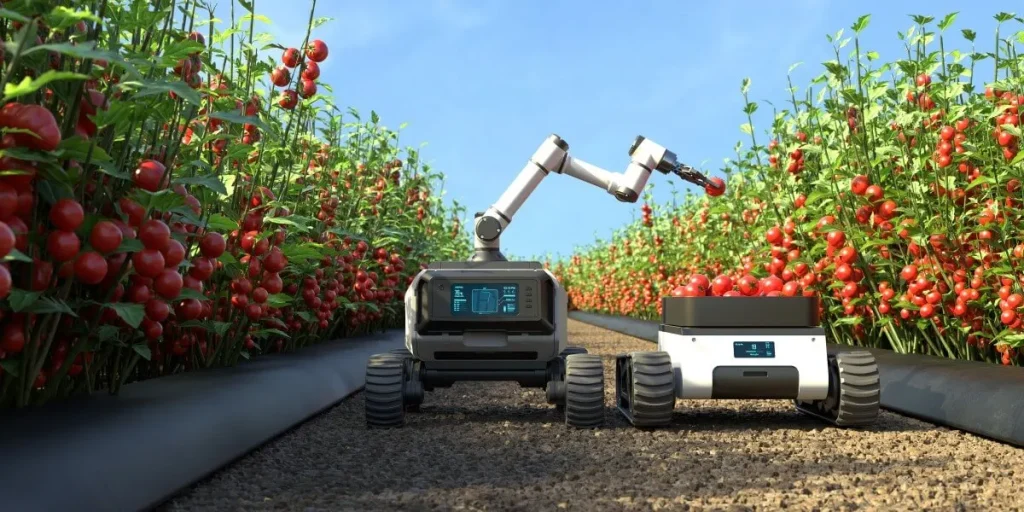
3. Internet of Things (IoT)
IoT devices collect and share real-time data across the food supply chain.
- Smart Sensors: Monitor temperature, humidity, and storage conditions in real-time, reducing spoilage.
- Connected Devices: Enable seamless communication between equipment, ensuring streamlined operations.
4. Automated Guided Vehicles (AGVs)
AGVs transport materials within factories and warehouses, reducing reliance on manual labor.
- Applications: Moving raw materials to production lines, distributing finished goods, or managing inventory.
5. Blockchain
Blockchain technology improves traceability and transparency in the food supply chain. It ensures food safety by recording every stage of the production process.
6. Computer Vision
Computer vision systems use cameras and sensors to inspect products, ensuring compliance with quality standards. These systems are commonly used in sorting, grading, and labeling processes.
Applications of Automation in the Food Industry
Automation has a wide range of applications in the food industry, enhancing every aspect of production and distribution.
1. Food Processing
Automation streamlines food processing by performing repetitive and labor-intensive tasks with precision.
- Example: Automated meat cutters and vegetable peelers improve consistency while reducing waste.
2. Quality Assurance
Automated systems inspect food products for defects, contaminants, or inconsistencies, ensuring that only high-quality items reach consumers.
- Example: AI systems detect discoloration, size irregularities, or foreign objects in products.
3. Packaging and Labeling
Robotic systems package products efficiently, while automated labeling machines ensure accurate and clear labeling.
- Example: Automated filling machines ensure consistent portion sizes for beverages or snacks.
4. Inventory Management
IoT and AI-powered systems manage inventory levels, ensuring timely restocking and minimizing overproduction in the food industry.
- Example: Real-time tracking systems prevent stockouts or spoilage.
5. Food Safety and Traceability
Automated systems monitor storage and processing conditions to prevent contamination and ensure compliance with safety standards. Blockchain ensures traceability by recording each stage of the supply chain.
- Example: Sensors that monitor temperature during cold chain logistics.
6. Customization and Personalization
Automation enables the production of customized products to meet consumer preferences.
- Example: Automated systems that create custom cakes or mix ingredients based on dietary requirements.
The Benefits
1. Increased Efficiency
Automation significantly reduces production time and minimizes human error, resulting in faster and more reliable operations.
2. Enhanced Food Safety
Automated systems maintain strict hygiene standards and detect contaminants or defects, ensuring compliance with safety regulations.
3. Cost Reduction
By minimizing waste, optimizing resource usage, and reducing labor costs, automation lowers operational expenses.
4. Consistent Quality
Robotic systems ensure integrity in food products, meeting consumer expectations for consistent taste, size, and appearance.
5. Improved Sustainability
Automation supports eco-friendly practices by reducing energy consumption, optimizing water use, and minimizing waste. So automation is good for our planet.
6. Scalability
Automated systems adapt to fluctuating production demands, making it easier for companies to scale their operations in no time.
Challenges of Food Industry Automation
While automation offers significant benefits in the food industry, it also presents challenges that must be addressed:
1. High Initial Investment
The cost of implementing automated systems can be prohibitive, particularly for small and medium-sized enterprises (SMEs).
2. Technical Complexity
Operating and maintaining automated systems require specialized knowledge and training, which can be a barrier for some businesses.
3. Resistance to Change
Some workers and businesses resist automation due to fears of job loss or skepticism about its benefits.
4. Integration Issues
Integrating automation into existing workflows can be complex and time-consuming, requiring careful planning and execution.
5. Data Privacy
As automation relies on connected systems, ensuring the privacy of sensitive data is a critical concern.
Real-World Examples
1. Nestlé
Nestlé has implemented robotics and AI to optimize production and ensure consistent quality across its products. Automated systems in its factories handle tasks like mixing, filling, and packaging.
2. Tyson Foods
Tyson Foods uses robotics and computer vision for automated meat processing, improving safety and efficiency while reducing labor costs.
3. Domino’s Pizza
Domino’s uses AI and robotics to enhance its delivery and pizza-making processes. Automated kitchens ensure consistent pizza quality, while AI-powered apps optimize delivery routes.
4. Coca-Cola
Coca-Cola employs IoT sensors and AI systems for inventory management, quality control, and supply chain optimization. Its automated production lines ensure precise filling and packaging of beverages.
The Future of Automation
The future of food industry automation is bright, driven by innovations in AI, robotics, and IoT. Key trends include:
1. Autonomous Kitchens
Robotic kitchens capable of preparing entire meals will become more common, especially in quick-service restaurants.
2. Predictive Maintenance
AI systems will predict equipment failures before they occur, reducing downtime and maintenance costs.
3. Advanced Customization
Automation in the food industry will enable hyper-personalized food production, catering to dietary preferences and health needs on a large scale.
4. Greater Traceability
Blockchain and IoT technologies will enhance transparency, ensuring that consumers can trace every ingredient back to its source.
5. Energy-Efficient Systems
Automation will focus on energy-efficient routines to reduce the carbon footprint of food production.

Conclusion
Food industry automation is transforming how food is produced, processed, and delivered. By embracing advanced technologies like robotics, AI, and IoT, the industry is achieving unprecedented levels of efficiency, safety, and sustainability.
While challenges such as high costs and technical complexity remain, the benefits of automation far outweigh the drawbacks. As these technologies become more accessible, even small-scale businesses will reap the rewards of automation.
In an era marked by rising consumer expectations and spikes of environmental concerns, the food industry finds itself at a pivotal crossroads. Automation emerges not merely as a choice but as an imperative, a critical step in the evolution of food systems worldwide. The path to a completely automated food ecosystem is set to be revolutionary, altering our perceptions and methodologies surrounding food production and consumption. It heralds a future where efficiency, sustainability, and innovation converge, ultimately redefining the agricultural landscape and our relationship with the very sustenance of life.


